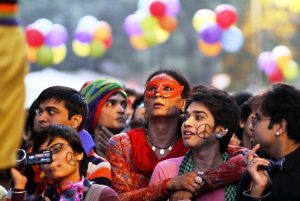
04-09-2017 (Important News Clippings)
To Download Click Here.
 Date:04-09-17
Date:04-09-17
Remove the barriers
Follow Niti Aayog recommendations on higher education, give students a chance

Date:04-09-17
Legalise sex by consent
Section 377 has become untenable in the light of Supreme Court’s historic privacy judgment
Ajit Prakash Shah and Vrinda Bhandari

Third, the existence of the law, regardless of its exercise, causes a chilling effect on the true expression of one’s identity. It encourages anti-gay violence and facilitates harassment, blackmail and exploitation by the police and larger society. As noted by the Supreme Court sexual orientation is an essential component of identity, whose fulfilment is hindered when there is a loss of privacy and dignity.Finally, the loss of privacy can lead to discrimination and denial of opportunities, leaving many amongst the LGBTQI community on the margins of society. The Supreme Court was cognisant of this in its judgment in NALSA, concerning transgender persons, where it observed “non-recognition of Hijras/ transgender persons denies them equal protection of law … thereby leaving them extremely vulnerable to harassment, violence and sexual assault.”A modern democracy rests on the twin principles of majority rule and the need to protect fundamental rights of all citizens. Fundamental rights are inalienable and transcend challenge or limitation. These rights identify subjects, withdraw them from political controversy, place them beyond the reach of majorities, and establish them as legal principles to be applied by courts equally for everyone.This was recognised by the court in Puttaswamy (the plurality opinion and separate concurrences), holding that privacy is an inalienable right that inheres in every person, which is reflected in the Fundamental Rights Chapter of the Constitution, rather than guaranteed by it. In this context, it is important to appreciate that just as homosexuality is not a ‘western import’, IPC was neither Indian, nor a gift from God. IPC was drafted by the British, based on prevailing Victorian notions of morality which were imported to India, and continue to remain here long after they have been discarded by the British.
The second aspect of a constitutional democracy relates to the counter-majoritarian role played by the judiciary, which has to ensure that a majoritarian government does not override minority rights. While law may be the product of representative majoritarian moral beliefs, constitutional guarantees (and constitutional morality) will lose significance if they are given majoritarian interpretations.There are many groups, or “discrete and insular minorities” who remain excluded from the everyday exchanges and compromises of democratic politics, which tend to prioritise political expediency over protection of rights. In 2016, the Lok Sabha voted against Shashi Tharoor’s bill to decriminalise homosexuality. In this background, Justice Kennedy’s majority opinion in the US Supreme Court gay marriage ruling in Obergefell vs Hodges bears reiteration: “The nation’s courts are open to injured individuals who come to them to vindicate their own direct, personal stake in our basic charter. An individual can invoke a right to constitutional protection when he or she is harmed, even if the broader public disagrees and even if the legislature refuses to act.”The Supreme Court in Puttaswamy has laid the ground for overruling Koushal. It is now up to the same court to recognise the validity of same-sex love. But that will not be enough. The Parliament must also act and pass a comprehensive anti-discrimination law, to protect such minority and disadvantaged groups. Only then will we move a step closer to achieving the constitutional goal of equality.
कुछ गलतियां इंसानी भी
प्राकृतिक आपदा भारत की एक प्रमुख समस्या है. इससे सूखा, बाढ़, चक्रवात और भूकंप आदि की समस्या से भारत ग्रसित है.
आर.बी. सिंह
करीब 85 फीसद भौगोलिक क्षेत्र और 24 राज्य कोई-न-कोई आपदा से पीड़ित हो रहा है. बाढ़ वर्तमान समय में भारत की एक प्रमुख आपदा बन गई है, जो बहुत जल्दी-जल्दी आती है और जिससे बहुत गंभीर रूप से जानमाल और धन की क्षति होती है. पूरे उत्तरी भारत में बाढ़ एक राष्ट्रीय विपदा के रूप में गंभीर समस्या पैदा करते हुए गरीबी, सामाजिक विषमता, बेरोजगारी आदि लाने में प्रमुख भूमिका अदा करती है. बाढ़ आने के बहुत सारे कारण हैं, लेकिन उनमें प्रमुख कारण जलवायु और स्थलाकृति है क्योंकि भारत में करीब 1200 मिलीमीटर के आसपास औसत वर्षा होती है. इसमें 85 फीसद वर्षा तीन-चार महीनों में जून तथा सितम्बर के बीच में होती है.कुछ सालों में बाढ़ हमारे मेगा सिटी की भी एक समस्या बन गई है, जिसमें चेन्नई और अभी मुबंई इसका एक जीता-जागता उदाहरण है. बिहार, असम और उत्तर प्रदेश तो प्रति वर्ष इससे पीड़ित होते हैं. बाढ़ मुख्यत: प्राकृतिक कारणों से हो सकती है और मानवीय कारण से या दोनों के सामूहिक संबंध से हो सकती है. अब हम इनके प्रमुख कारणों को उद्धृत करना चाहेंगे और बिहार व असम में जो बाढ़ आती है वह उच्च भूमि और निम्न भूमि के संबंधों का एक स्वरूप है. जैसे-नेपाल के पहाड़ी क्षेत्रों में वनों की कटाई और मानवीय क्रिया-कलापों में वृद्धि के कारण रन अप (प्रवाह की दिशा) अधिक होती है. जब एक साथ काफी मात्रा में वर्षा होती है और नीचे की भूमि जो वनाच्छादित नहीं है, वह काफी तेजी से नदियों की तरफ बढ़ती है. यह मॉनसून का एक मुख्य बिंदु है.
एक मीटर जलस्तर उठाने पर इस संबंध में हम टोपोग्राफिकल शीट जिससे धरातल की ऊंचाई का भी पता लग सकता है, लागू कर सकते हैं. लोगों को याद होगा बिहार में कोसी नदी में बहुत भीषण बाढ़ 2008 में आई थी, जो बांध में कटाव से इतना विकराल रूप धारण कर लिया था जिसमें 527 जानें गई थीं. 19 हजार पशुओं की मौत हो गई थी और करीब 2 लाख से ऊपर घरों को नुकसान हुआ जबकि 3 करोड़ से ज्यादा लोग पीड़ित हुए थे. 2017 की बाढ़ में भी 500 से अधिक लोग मर चुके हैं.यदि वैिक स्तर पर डेटा को देखें तो जितने लोग आपदा से पीड़ित होते हैं, उनमें 26 फीसद बाढ़ से होते हैं. और जितनी आपदा घटित होती है उसमें 43 फीसद बाढ़ ही वजह होती है. इसके अलावा, हमें मौसम के पूर्वानुमान की सटीक जानकारी में मददगार उपकरणों का इस्तेमाल करना होगा. केंद्रीय जल कमीशन की जिम्मेदारी के साथ-साथ जनता में भूमि उपयोग नियोजन को प्रोत्साहित करते हुए नये-नये जीविका के साधनों को भी बताना होगा.जैसे; अधिक जल प्रभावित क्षेत्रों में बांस की खेती को प्रोत्साहित किया जाए. जिससे लोगों को आय के साधन मिल सके. इसी तरह मुजफ्फरपुर से दरभंगा का जो लंबा स्ट्रेच है, उस इलाके में मखाना की खेती बड़े पैमाने में होती है. लेकिन बड़ी समस्या उसके प्रसंस्करण की है. इस सुविधा के अभाव में वहां के लोगों की आमदनी पर बुरा असर पड़ता है. सरकार को इस विषय पर संजीदगी से विचार करना चाहिए. इसी तरह एक समय बिहार में साठी धान की खेती का अच्छा-खासा चलन था. साठी धान जो 60 दिनों में तैयार हो जाता था. लेकिन पिछले कुछ सालों में इसकी खेती खत्म सी हो गई है. इस पर किसी का भी ध्यान नहीं है. इसकी खेती को एक बार फिर से प्रोत्साहित करने की जरूरत है.
Date:02-09-17
..तो ही होगी उत्तम खेती
हालांकि यह कहना अन्याय होगा कि सरकार न तो फसली उत्पाद का न्यूनतम समर्थन खरीद मूल्य बढ़ाएगी और न ही न्यूनतम समर्थन खरीद मूल्य पर अधिकतम फसल की खरीद सुनिश्चित करेगी, बेहतर हो कि किसान अपने उत्पादन की लागत घटाए; लेकिन सरकारी रवैये और कर्ज माफी से संतुष्ट हो जाने के रूप में किसान संगठनों द्वारा पेश नरमी का यथार्थ यही है.
अरुण तिवारी
यथार्थ यह भी है कि न्यूनतम समर्थन खरीद मूल्य को लागत के डेढ़ गुना तक बढ़ाने को लेकर केंद्र सरकार हाथ खड़े चुकी है. हमारी सरकारों की रु चि, न तो न्यूनतम समर्थन खरीद मूल्य के दायरे में शामिल फसलों की सरकारी खरीद की क्षमता बढ़ाने में है, और न ही किसान को न्यूनतम समर्थन खरीद मूल्य से कम पर फसल बेचने के लिए विवश करने वाले खुले बाजार पर सख्ती बरतने में. उत्पादक से उपभोक्ता के बीच सक्रिय दलालों के मुनाफे को नियंत्रित करने में भी सरकारों की कोई खास रुचि दिखाई नहीं दे रही. यह रु चि पैदा करना जरूरी है. इसके लिए जन दबाव बनाने के जो भी शांतिमय तरीके हों; आजमाने चाहिए. लेकिन नहीं भूलना चाहिए कि सरकार और बाजार..दोनों ही कभी भी किसान के नियंत्रण में नहीं रहे. जब तक किसान अपनी फसल के भंडारण की स्वावलंबी क्षमता हासिल नहीं कर लेता; तब तक आगे भी ऐसी कोई संभावना नहीं होने वाली. लिहाजा, सरकार, कर्ज और बाजार के भरोसे खेती करना अब पूरी तरह जोखिम भरा सौदा है. अत: जरूरी है कि फसल उत्पादन लागत में घटोत्तरी के उपायों पर अमल शुरू हो. यह कैसे हो? कृषि में लागत मूल्य के मुख्य 10 मद हैं: भूमि, मशीनी उपकरण, सिंचाई, बीज, खाद,कीट-खरपतवारनाशक,मड़ाई, भंडारण, समय और आवश्यक श्रम. कृषि जरूरत की इन चीजों पर किसान का स्वयं का नियंत्रण हुए बगैर न कृषि की लागत घटाई जा सकती है, और न ही खेती को स्वाभिमानपूर्वक उदर-पोषण करने वाले कार्य की श्रेणी में लाया जा सकता है. जो भूमिहीन किसान, दूसरों के खेत किरायेदारी पर लेकर खेती करते हैं, उनकी भूमि किरायेदारी लागत घटाने के लिए जबरन किया गया कोई भी प्रयास अंतत: सामाजिक विद्वेष खड़ा करने वाला साबित होगा.